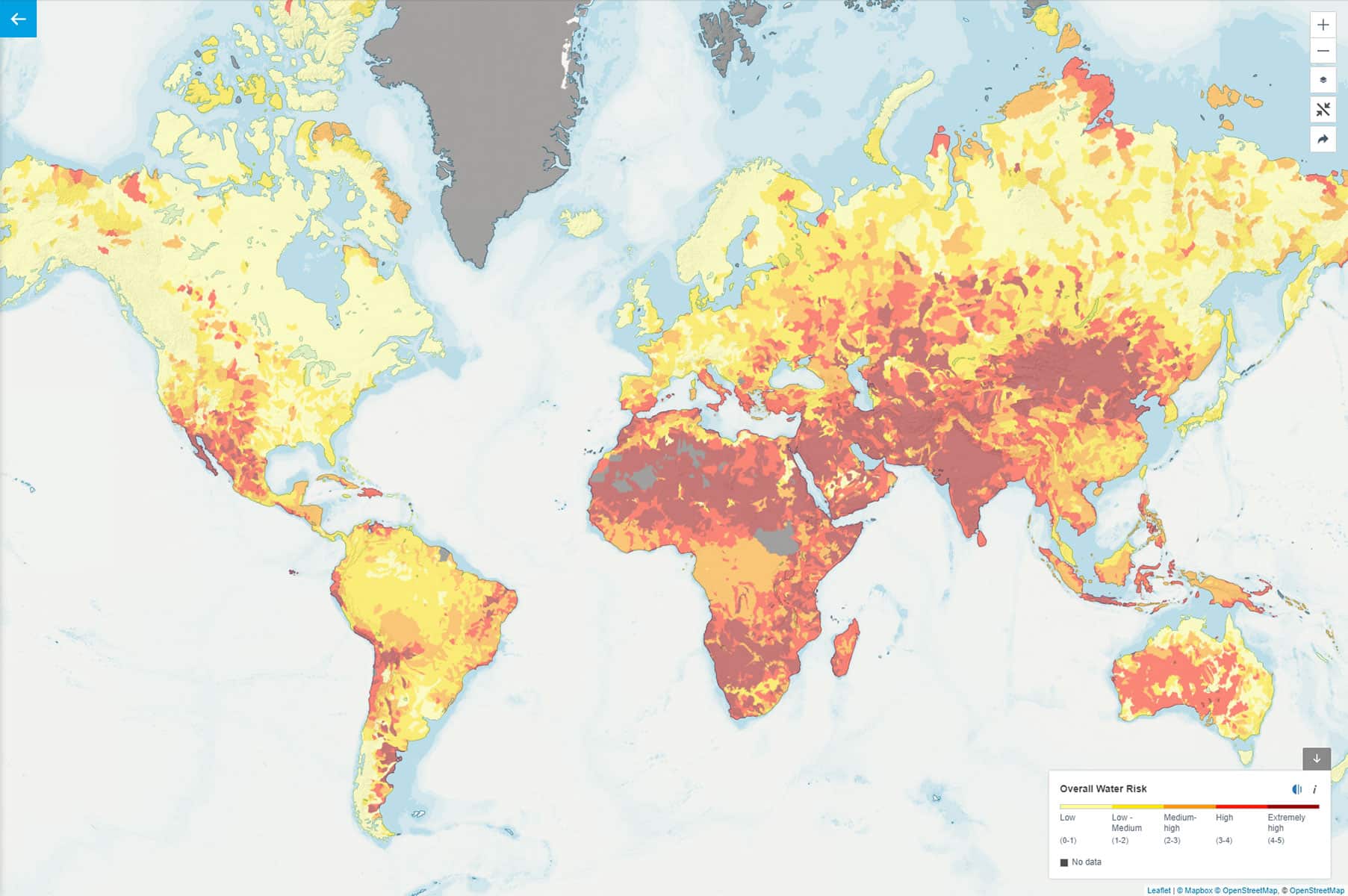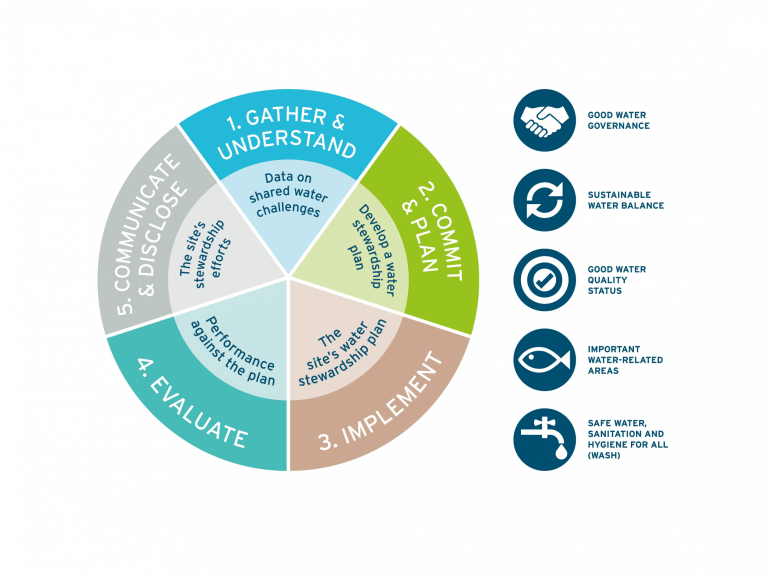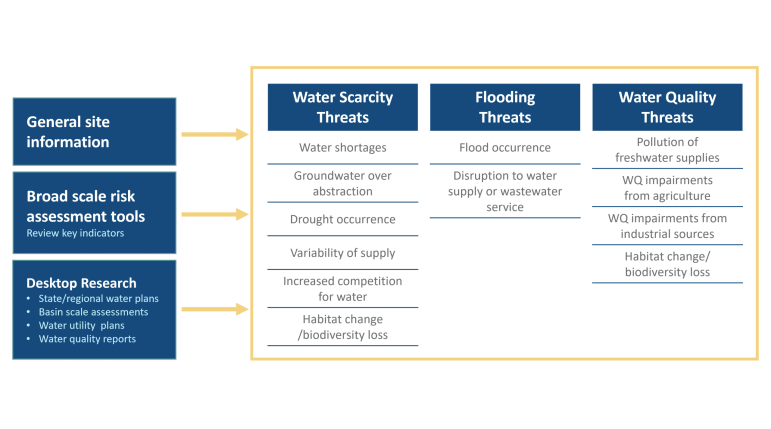
Assessing Water-Related Risk as a Foundation for Stewardship
Where should a company start to address water risk? A water risk assessment is a critical step to identify water risk exposure and set a foundation for framing water-related goals, organizing a response to mitigate risks, and addressing shared water challenges in the places that matter most across their value chain.
By Pranesh Selvendiran, Senior Environmental Engineer (Ann Arbor, MI) and Laura Weintraub, Vice President (Ann Arbor, MI)
December 14, 2022
Water is a critical resource for every business. Companies face water-related risks driven by various factors, including competition for water, pollution, regulation, and climate change. Where should a company start to address water risk? A water risk assessment is a critical step to identify water risk exposure and set a foundation for framing water-related goals, organizing a response to mitigate risks, and addressing shared water challenges in the places that matter most across their value chain.
One vehicle for companies to navigate water-related risk is through the implementation of the Alliance for Water Stewardship (AWS) Standard. The AWS Standard is a robust, internationally recognized framework and certification for organizations to demonstrate a commitment to water stewardship. During Step 1 of AWS Standard implementation, sites conduct an exercise to identify and prioritize water-related risk (see Indicator 1.7) and also gain a broader understanding of shared water challenges in the local catchment (see Indicator 1.6). This process helps inform the development of the site’s water stewardship plan. Through the development of a water stewardship plan, a site sets targets and implements responsible practices that mitigate water risks and address shared water challenges.

Businesses can face water-related risks across three categories: physical (water quantity and quality), regulatory (laws), and reputational (public perception of a brand). Any of these risks can lead to financial risk. Water supply or supply chain disruptions can result in lost revenue. Higher operating costs will be incurred if the cost of water supply, water treatment, or energy production increases. There are also potential costs related to permitting, compliance, fines, litigation, or insurance. Finally, there are costs if there is damage related to the public perception of a brand.
Businesses can face water-related risks across three categories: physical (water quantity and quality), regulatory (laws), and reputational (public perception of a brand). Any of these risks can lead to financial risk.
Water stewardship is a continuous journey that requires businesses to move beyond internal water management and commit to the sustainable management of shared water resources through collective action and partnership with other businesses, NGOs, and communities. While each organization has a unique path and its own water stewardship journey, a common set of elements play an important role and are woven together to develop a holistic water stewardship strategy. At LimnoTech, we recommend that our clients first understand site water risks, shared water challenges, water stakeholders, and ongoing initiatives at each location or site of interest.
LimnoTech has conducted water risk assessments for companies across a range of sectors (food and beverage, hospitality, electric power, tech, agriculture) and across all geographies. We work with our clients to develop a tailored approach and carefully consider the unique context of each site and local watershed. Most companies screen for potential risk by examining their entire, sometimes global, set of assets and operations. Our water risk assessment approach and methodologies follow best practices and are consistent with the guidelines prepared by the CEO Water Mandate, World Resources Institute (WRI), World Wildlife Fund (WWF), AWS, and other reputable organizations.
The approach involves both qualitative and quantitative assessments to identify key risk drivers that impact direct operations, local watersheds, and the communities where an organization operates. Components typically include:
- Site water balance to track site water source and discharges.
- Physical scope summary to understand the site and source watersheds for the facility.
- Risk indicator selection from existing frameworks (e.g., WRI Aqueduct Water Risk Atlas, WWF Water Risk Filter), including physical indicators that address water scarcity, flooding, and water quality, and potentially, reputational and regulatory risks.
- GIS spatial analysis to extract water risk indicators for the site locations.
- Site-specific review to cross-check results from indicators and risk screening tools.
- Desktop research to gain additional insight into local shared water challenges that are relevant to a site.
- Climate change effect considerations to factor in disruptions in hydrologic cycles and water supply.
- Ranking of sites to determine the highest-risk locations and prioritize actions.

After the synthesis of these components, we formulate an approach to identify the risk pathways linking physical quantity risk with site dependency on water and any specific water-related threats to the site’s operations. Sites are ranked high, medium, or low for exposure to water-related risks to help prioritize response actions. A summary of meaningful interventions that are relevant for mitigating water-related risks provides a complement to the risk assessment.
A robust risk assessment can help a company identify where to start its important work of water stewardship. It is most valuable to work in regions with the highest risk. A company may choose to implement the AWS Standard at one or more high-risk sites. The outcomes of a water risk assessment will help support the framing and definition of a site water stewardship plan as part of the AWS Standard process. The outcomes of a risk assessment can also support responses to various water disclosure and reporting frameworks, including CDP Water Security, Sustainable Accounting Standards Board (SASB), and other relevant platforms.
A robust risk assessment can help a company identify where to start their important work of water stewardship – with the most valuable work in the highest risk regions.
LimnoTech’s water stewardship team strives to help our clients set a strong foundation and clear direction of focus for their water stewardship journey. With a water risk assessment in hand, our clients are ready to develop on-site water strategies to address identified risks and opportunities and set goals to work “outside the fence line” in collaboration with NGO partners and local stakeholders.
If you would like to discuss your water stewardship or water risk assessment needs, please feel free to contact Pranesh Selvendiran at pselvendiran@limno.com.
This article is the third in a series of articles authored by LimnoTech staff on water stewardship. Follow us on LinkedIn or Twitter (@LimnoTech), and check the Insights & Perspectives page on our website for more information and updates.
Links to the other water stewardship articles in this series are provided below:
The Alliance for Water Stewardship Standard – Framing a Decade of Water Stewardship
Understanding and Engaging Water-Related Stakeholders
Success Strategies for Developing a Site Water Stewardship Plan within the AWS Standard Framework
Strong Site Teams Lead to Successful Water Stewardship
Pranesh Selvendiran, PhD, is a Senior Environmental Engineer at LimnoTech. He has 15 years of technical and project management experience through a wide variety of projects in the U.S. and around the world. Pranesh’s principal areas of expertise include water accounting and footprinting, operations and supply chain risk assessments, development and applications of water benefit methodologies, water strategy development, CDP water disclosure and reporting, development of watershed and hydrologic models, evaluation of fate and transport (mercury, nutrients, and sediments), conceptual design for web-based tool development, and project management. He supports LimnoTech’s water sustainability consulting services, helping clients assess and improve water management and develop strategies to minimize water quantity and quality impacts and risks. He has led and supported water risk assessments for several global companies and evaluated the water benefits of numerous water stewardship projects implemented worldwide by multiple multinational corporations. He has extensive experience with risk assessment tools, data analysis and interpretation, and developing technical reports. Pranesh is an accredited consultant for the AWS Water Stewardship.
Laura Weintraub, PE, is a Vice President and Water Resource and Environmental Engineer with over 25 years of experience supporting public, private, and research clients in the areas of watershed planning, water sustainability, stormwater management, source water protection, and decision-support system development. She currently co-directs LimnoTech’s corporate water stewardship practice area, where she supports numerous companies in tech, food & beverage, manufacturing, electric power, agriculture, and other sectors. Laura leads projects to support sustainability-focused companies with water stewardship strategy and target setting; water stewardship program development and implementation; water accounting, footprinting, and circularity assessments; context-based water risk assessments; replenish project scoping and benefit quantification; Alliance for Water Stewardship Standard training and certification; and sustainability reporting. She has also led efforts to evaluate water risk and sustainability metrics, assess opportunities for alternative (degraded) water supply use, and quantify the economic costs and benefits of water stewardship projects implemented outside the fenceline of an organization’s operational boundaries.
The content herein is the author’s opinion and not published on behalf of the Alliance for Water Stewardship (AWS). The author holds an AWS Professional Credential and this piece of publishing helps fulfill their Continuing Contribution Units requirements. For more information about AWS or the AWS Professional Credentialing Program please visit https://a4ws.org/.




